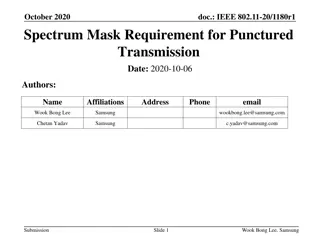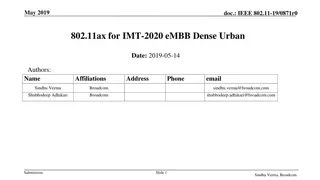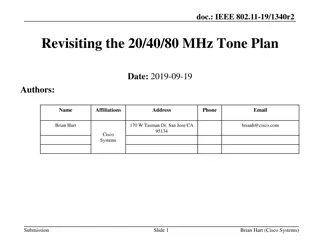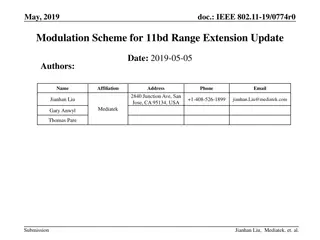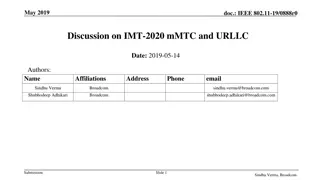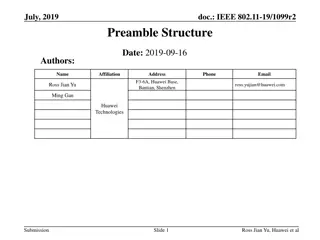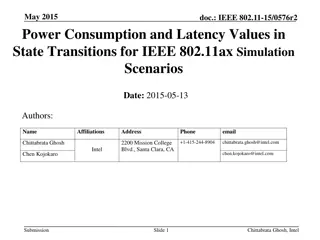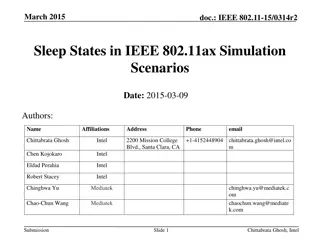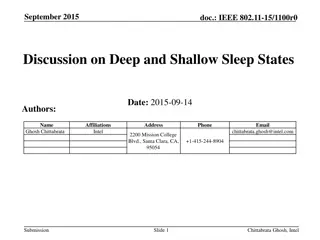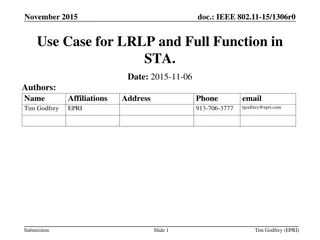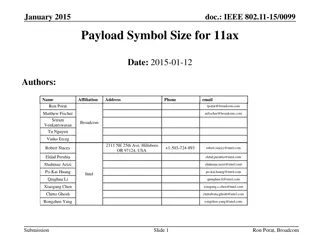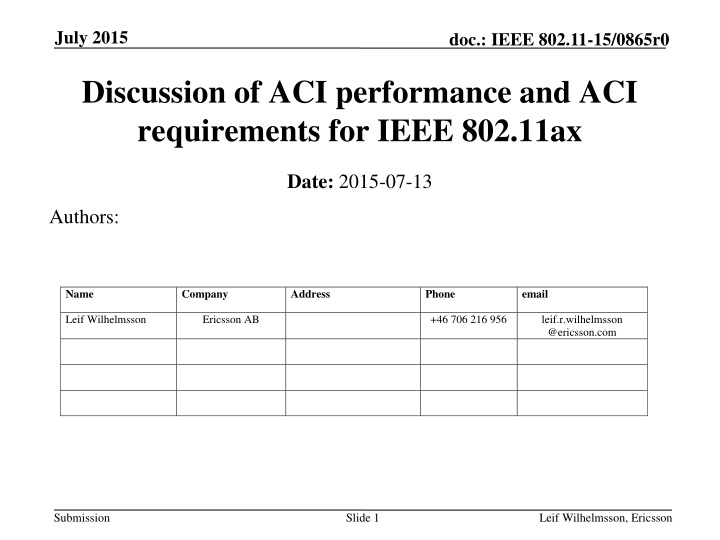
ACI Performance & Requirements in IEEE 802.11ax
Explore the discussion on Adjacent Channel Interference (ACI) performance as determined by Adjacent Channel Leakage Ratio (ACLR) and Adjacent Channel Selection (ACS). Comparisons with LTE, evaluation methodologies, and possible improvements are covered for IEEE 802.11ax. Terminology, required effective SNR for different MCS levels, and performance metrics are detailed in this document.
Download Presentation

Please find below an Image/Link to download the presentation.
The content on the website is provided AS IS for your information and personal use only. It may not be sold, licensed, or shared on other websites without obtaining consent from the author. If you encounter any issues during the download, it is possible that the publisher has removed the file from their server.
You are allowed to download the files provided on this website for personal or commercial use, subject to the condition that they are used lawfully. All files are the property of their respective owners.
The content on the website is provided AS IS for your information and personal use only. It may not be sold, licensed, or shared on other websites without obtaining consent from the author.
E N D
Presentation Transcript
July 2015 doc.: IEEE 802.11-15/0865r0 Discussion of ACI performance and ACI requirements for IEEE 802.11ax Date: 2015-07-13 Authors: Name Company Address Phone email Leif Wilhelmsson Ericsson AB +46 706 216 956 leif.r.wilhelmsson @ericsson.com Submission Slide 1 Leif Wilhelmsson, Ericsson
July 2015 doc.: IEEE 802.11-15/0865r0 Abstract Adjacent Channel Interference (ACI) performance is essentially determined by the Adjacent Channel Leakage Ratio (ACLR) and Adajcent Channel Selection (ACS) The impact of ACLR was discussed in [2] using the TX spectrum mask for a fixed MCS and in [3] using MCS dependent ACLR. In this contribution we discuss the need for also including ACS and a possible way to do so ACI performance is also of vital importance for inter-standard coexistence. In this contribution we compare with LTE and discuss the feasibility to improve 802.11ax in this respect Submission Slide 2 Leif Wilhelmsson, Ericsson
July 2015 doc.: IEEE 802.11-15/0865r0 Outline Methodology for evaluation ACI performance required and simulated A rough comparison with LTE Possible improvements? Conclusions Submission Slide 3 Leif Wilhelmsson, Ericsson
July 2015 doc.: IEEE 802.11-15/0865r0 Methodology for evaluation Spectrum analyzer Shaping OFDM OFDM SINR PA + + CSF OFDM Shaping X PA WGN ??2??? ??2??? The evaluation is done in a simplified test bench, where the metrics are based on the estimated SINR (-EVM) in the IQ-diagram The simulations are only done for the 20 MHz channel The PA non-linearity is modelled using Rapp s model with p = 3 and different values of OBO Submission Slide 4 Leif Wilhelmsson, Ericsson
July 2015 doc.: IEEE 802.11-15/0865r0 ACI Performance - Terminology 1 ???? = 1 1 ????+ ??? ACIR = Adjacent Channel Interference Ratio ACLR = Adjacent Channel Leakage Ratio ACS = Adjacent Channel Selectivity In related contributions, ACLR (conservatively) considered but ACS neglected Here ACIR is instead found directly from specification and by simulations Slide 5 Submission Leif Wilhelmsson, Ericsson
July 2015 doc.: IEEE 802.11-15/0865r0 ACI Performance MCS Required effective SNR [dB] MCS = 0 1 MCS = 1 4 MCS = 2 7 MCS = 3 10 MCS = 4 13 MCS = 5 17 MCS = 6 19 The required C/I is obtained from Table 22-26 The effective SNR requirement for the corresponding MCS is taken from the EMD. The used values for BCC are to the right. LDPC 2 dB better (simpler) The effective SNR (-EVM) is estimated in the IQ- diagram The effective SNR C/I (in dB) is the estimated ACIR SNR is set to 35 dB MCS = 7 20 MCS = 8 24 MCS = 9 26 Submission Slide 6 Leif Wilhelmsson, Ericsson
July 2015 doc.: IEEE 802.11-15/0865r0 ACI Performance - Simulated OBO = 5dB OBO = 7dB OBO = 9dB The BW of the channel selective filter (CSF) is 9 MHz and 9.6 MHz for 802.11ac and 802.11ax, respectively. In all cases a 6th order Chebychev filter The OBO for the desired signal is 9 dB in all cases, the impact of OBO of the interfering signal is shown above. Small impact for 802.11ax => ACS is limiting. Note that the ideal gain by using a larger FFT in 802.11ax compared to 802.11ac is not really seen Submission Slide 7 Leif Wilhelmsson, Ericsson
July 2015 doc.: IEEE 802.11-15/0865r0 Including ACI Performance in System Simulations In [2] it was shown that ACI had an impact, although only ACLR was considered If ACI is to be included, also ACS needs to be modelled Using the ACIR performance estimated from specification a singel number can be used However, if the margin for real implementations is as huge as for sensitivity it would give too pessimistic results Submission Slide 8 Leif Wilhelmsson, Ericsson
July 2015 doc.: IEEE 802.11-15/0865r0 ACI and Inter-standard Coexistence There is currently discussion about coexistence between LAA and Wi-Fi Initially it was mainly about sharing the same channel in a fair way, but lately also impact of ACI has been considered e.g. [4] LTE has an advantange compared to 802.11ax due to 2k FFT instead of 256 point, allowing better ACLR 1 MHz guardband instead of about 400 kHz, allowing better ACS In addition, LTE has fundamentally different requirements for the eNB and the UE Submission Slide 9 Leif Wilhelmsson, Ericsson
July 2015 doc.: IEEE 802.11-15/0865r0 ACI and Inter-standard Coexistence The ACIR requirements for 802.11ac is about 18 dB (based on C/I performance and SNReff requirements) For LTE eNB, ACLR = 45 dB and ACS = 45 dB For LTE UE, ACLR = 30 dB and ACS = 27 dB =>ACIR eNB = 30 dB =>ACIR UE = 27 dB In operator deployed scenarios where the AP may have considerably higher TX power, allowing very relaxed ACLR and ACS may Degrade system performance Make 802.11 look bad compared to competing standards Submission Slide 10 Leif Wilhelmsson, Ericsson
July 2015 doc.: IEEE 802.11-15/0865r0 ACI and Inter-standard Coexistence OBO = 5dB OBO = 7dB OBO = 9dB For 802.11ax, the ACIR only depends slightly on OBO, as it is largely determined by the ACS Although ACS is very implementation dependent and can be enhanced, with a too relaxed specification it seems there is a risk 802.11ax may have a significant disadvantage in comparison with e.g. LTE Based on preliminary evaluations, there seems to be about 10 dB difference Submission Slide 11 Leif Wilhelmsson, Ericsson
July 2015 doc.: IEEE 802.11-15/0865r0 Possible Improvements? In cellular systems like LTE, the radio requirements are typically very different for the eNB and the UE, e.g. concerning ACLR and ACS With 802.11ax targeting similar use cases, it seems reasonable to consider a similar approach where APs, especially in case of high TX power, have more strict requirements Submission Slide 12 Leif Wilhelmsson, Ericsson
July 2015 doc.: IEEE 802.11-15/0865r0 Conclusions ACI performance for 802.11ax is expected to be limited by ACS rather than ACLR for most cases => ACI performance can t be studied just looking at ACLR Competing technologies are considerably better. It is possible to decrease this gap e.g. by having more stringent radio requirements for APs with high TX power Submission Slide 13 Leif Wilhelmsson, Ericsson
July 2015 doc.: IEEE 802.11-15/0865r0 Straw Poll Should ACI performance be included in Evaluation Methodology Document? Y/N/A: Submission Slide 14 Leif Wilhelmsson, Ericsson
July 2015 doc.: IEEE 802.11-15/0865r0 Straw Poll Would it be desirable to have different radio requriements (ACLR and ACS) for high TX power APs and non-AP STAs if this results in better performance? Y/N/A: Submission Slide 15 Leif Wilhelmsson, Ericsson
July 2015 doc.: IEEE 802.11-15/0865r0 References 1. 11-15/0330r1, OFDMA Numerology and Structure 2. 11-15/0564, 802.11ax Calibration and Modeling Adjacent Channel Interference 3. 11-14/00865r1, ACI and AACI for 802.11ax System Simulations 4. R4-153538, Adjacent channel coexistence evaluations for LAA-LAA deployment scenario Submission Slide 16 Leif Wilhelmsson, Ericsson
July 2015 doc.: IEEE 802.11-15/0865r0 Methodology for evaluation, cont d Channel estimation is done on one noise and interference free symbol (only impacted by PA and CSF), as assuming a too simplistic channel estimation algorithm under realistic conditions will give too poor results The IFFT is run at 80 MHz A simple 1 sample window is used to meet the TX spectrum far out. No additional shaping One concern by widening the TX spectrum mask is that the ACI performance may degrade. The ACI performance is compared to 802.11ac and evaluated against the 802.11ac requirements A 6th order (analog) Chebychev filter is assumed, before down- sampling to Nyquist. 3dB BW equal to passband of desired signal. No additional filtering is used. Submission Slide 17 Leif Wilhelmsson, Ericsson
July 2015 doc.: IEEE 802.11-15/0865r0 Impact of OBO EVM requirement very dependent on MCS. Corresponding OBO requirement: QPSK ~ 3dB, 16QAM ~ 5dB, 64QAM ~ 8dB, and 256QAM ~ 9dB =>Using spectrum mask to determine ACLR for high MCS is very pessimistic Submission Slide 18 Leif Wilhelmsson, Ericsson
July 2015 doc.: IEEE 802.11-15/0865r0 ACI Performance - Simulated OBO = 5dB OBO = 7dB OBO = 9dB The same simulations as on the previous page, but now with a 10th order filter in order to obtain very high ACS and study ACLR. ACLR may be better for 802.11ax, but this seems to be true only for large OBO Submission Slide 19 Leif Wilhelmsson, Ericsson



